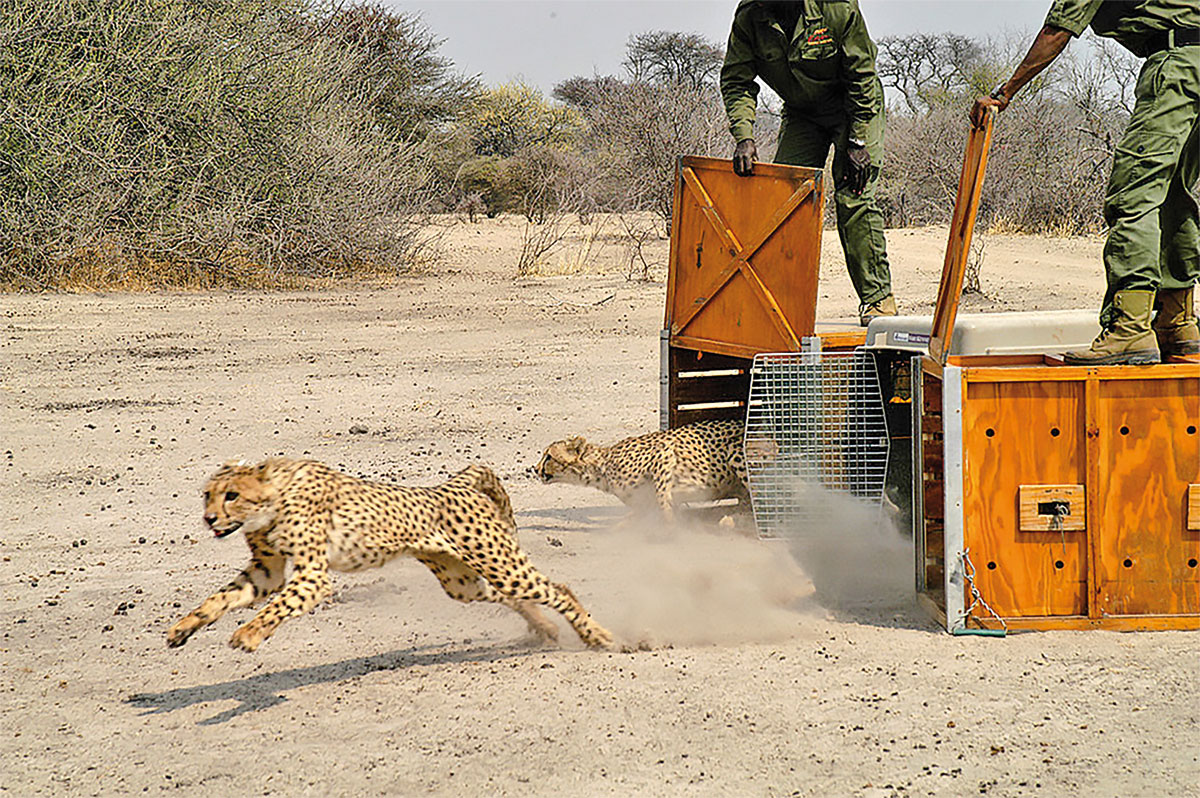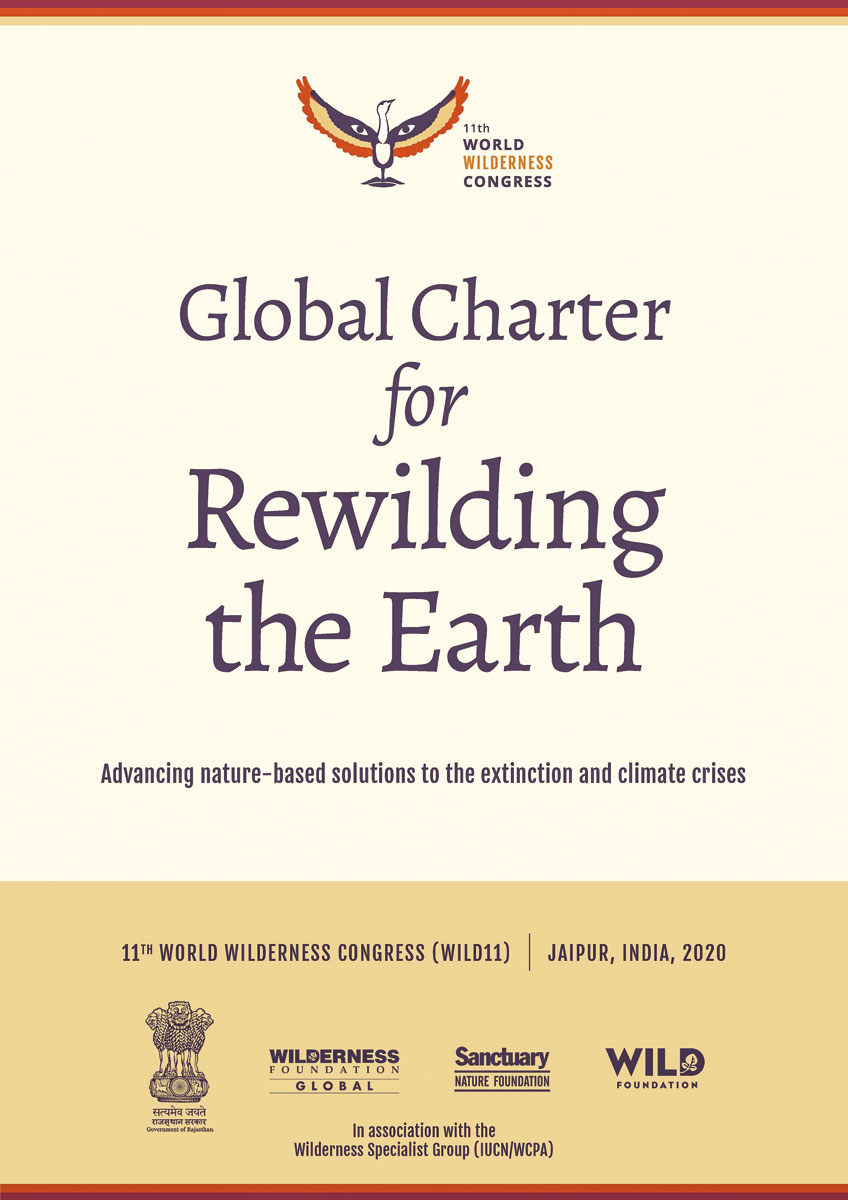The Power Of Rewilding Is In Both Principle And Practice
First published in Sanctuary Asia,
Vol. 43
No. 10,
October 2023
By Vance G. Martin and Tom Butler
WILD11, the 11th World Wilderness Congress, was planned by WILD Foundation, Sanctuary Nature Foundation, and scores of organisations, governments and experts over a period of 18 months and was scheduled to convene in Jaipur, Rajasthan in March, 2020. Owing to the COVID-19 pandemic, the Congress was necessarily cancelled. Numerous products were developed for a global launch at that Congress. One of them was the Global Charter for Rewilding the Earth: Advancing Nature-based Solutions to the Extinction and Climate Crises. Developed by a diverse group of experts from five continents, the Charter is unique in global conservation because it clarifies the principles that undergird the practice of rewilding. In this article, Vance G. Martin and Tom Butler draw heavily and specifically from the text of the Charter, with permission of the WILD11 Executive Committee.
Rewilding – both as an aspirational vision and a practical, visible process, that nature leads with our support – is powerful because it produces individual and collective benefits. In an era characterised by climate breakdown and loss of life’s diversity, rewilding offers the possibility for more: More beauty. More abundance. More equity among all creatures that inhabit the Earth – including humans. It offers an invitation to people across the globe, from every background, to be meaningfully engaged in a transformative movement for people and the planet.
When American conservationist Dave Foreman coined the term “rewilding”, he used it as shorthand for wilderness recovery on a scale that allows apex carnivores such as wolves, tigers, pumas, and sharks to resume their vital role in healthy ecosystems. Decades later, the word “rewilding” has been embraced by conservationists around the world to include ecological restoration efforts at many scales. Stories in this issue of Sanctuary Asia show how landscape-scale efforts, local initiatives, and projects accomplished through global alliances and through neighbourhood volunteers can embody the healing power of rewilding.
However, before we dive into specific practices and places, let’s first consider what rewilding means to us as individuals, and why it can be as transformative as we propose. By considering the principles that enliven and inform the practice of rewilding, we can orient ourselves to truly transforming the world and ourselves. While specific actions such as establishing Protected Areas and reintroducing missing species are crucial to a rewilding agenda, the bonus outcome from rewilding is a change in consciousness that can fuel the social movement needed to change our planetary course.
First… what is it? Rewilding means helping nature heal. Rewilding means giving space back to wildlife and returning wildlife back to the land and the seas. Rewilding means the mass recovery of ecosystems and the rejuvenation of the life-supporting functions they provide. Rewilding means restoring and protecting specific places – on land and in the ocean – where nature is free to direct the ebb and flow of life. Rewilding is about allowing natural processes to shape whole ecosystems so that they work in all their colourful complexity to give life to the land and the seas. Such wild lands and waters are critical to sustain ecological vitality by supporting intact food webs and natural processes.
Rewilding is also about the way we think. It is about understanding that we are one species among many, bound together in an intricate web of life that ties us to the atmosphere, the weather, the tide, the soils, the freshwater, the oceans, and all living creatures on the planet. The more we learn about and practice rewilding, the more we understand how our species is part of Earth’s great community of life.

Cheetahs being released into the wild in Namibia. When Dave Foreman coined the term ‘rewilding’, he referred to wilderness recovery on a scale that allows apex carnivores to resume their vital role in healthy ecosystems. Photo: Cheetah Conservation Fund.
Principles For Rewilding
The ecosphere is based on relationships
Rewilding our hearts and minds is fundamental. Thus, a crucial first step towards widespread societal embracing of rewilding is to accept, celebrate, and activate the principle of ‘relationship’, the essential function and ethic that sustains life on Earth.
Bringing hopeful stories to life
Rewilding is about telling the story of a richer, more vital future but also about executing successful projects – empowering others to support and join this movement by demonstrating positive results.
Embracing natural solutions and thinking creatively
Rewilding can help solve environmental, social, and economic problems. Conservationists should design and implement rewilding projects in ways that are ambitious, strategic, opportunistic, and entrepreneurial.
Protecting the best, rewilding the rest
Conserving the most intact remaining habitats and key biodiversity areas as well as working to recover lost interactions of nature at all levels and restore habitat connectivity in land- and seascapes at every scale, shows the complementarity of rewilding and traditional approaches to nature protection.
Letting nature lead
As in medicine, rewilding efforts should emphasise helping nature’s inherent healing powers regain strength, with the goal that management interventions would decline or cease over time. Humility will allow us to
cede control, enabling restored natural processes to shape dynamic land- and seascapes of the future.
Working at nature’s scale
Natural systems operate at many scales continuously. Similarly, global rewilding efforts can work place by place, incrementally and at various scales to rebuild wildlife diversity and abundance and allow natural processes, such as disturbance and dispersal, to create resilience in natural and social systems.
Taking the long view
To ensure sustained positive effects on biodiversity and quality of ecosystem services (such as carbon storage), rewilding efforts must be planned and implemented with a long-term perspective.
Building local economies
Creating, expanding, and restoring natural areas with abundant wildlife can provide new opportunities to create economic vitality and generate livelihoods linked to nature’s vitality.
Understanding ecological history and acting in context
Successful rewilding efforts are informed by deep knowledge of the environmental and cultural history of particular places. Working within the social, biological, and physical realities of a territory will foster successful rewilding outcomes.
Evidence-based adaptive management
Learning from others, using the best-available evidence, gathering and sharing data, and having the confidence to learn from failure will lead to success and grow the institutional capacity of the rewilding movement.
Working Together For The Good Of Ourselves And Nature
Effective advocates for nature build coalitions and forge partnerships based on respect, trust, and common interest. Connecting different disciplines, working intergenerationally and honouring the perspectives of diverse stakeholders will produce successful rewilding results.

Nature also has her own needs. Terry Tempest Williams once wrote, “The eyes of the future are looking back at us and they are praying for us to see beyond our own time. They are kneeling with hands clasped that we might act with restraint, that we might leave room for the life that is destined to come.” In this present moment of profound decision for humanity, when our choices will affect every person on Earth, our descendants, and all our relations in the community of life, rewilding offers a wildly hopeful course of action.
Vance G. Martin created and built-out the WILD Foundation for 40 years, working on projects around the world as well as convening (with many partners) the 3rd through 11th World Wilderness Congress. Since recently handing over WILD to a talented leadership team, Vance operates as President Emeritus of Wilderness Foundation Global, an alliance based in the Global South, and is an active board member of numerous initiatives in many countries, including the Sanctuary Nature Foundation. He also continues a very active, long-term role in the World Commission on Protected Areas (IUCN) as Founder/Co-Chair of the Wilderness Specialist Group. Tom Butler is the senior fellow of Northeast Wilderness Trust (USA) and a board member of Tompkins Conservation, a U.S.-based non-profit that, for three decades, has led large-scale rewilding projects in Chile and Argentina. He is the author of several books including Wildlands Philanthropy, and has served as a lead author/editor on the Global Charter for Rewilding the Earth.



